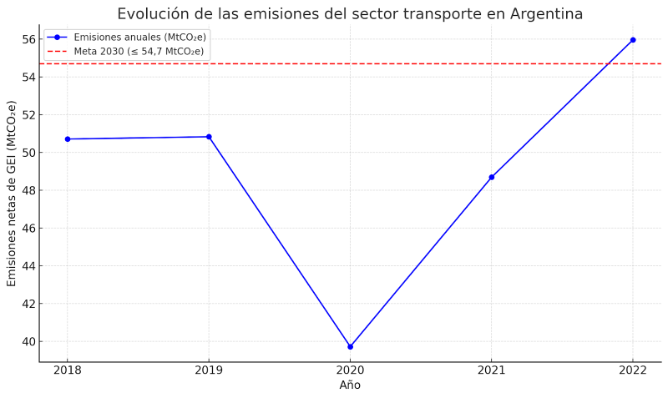11.4
Published onNet emissions from the transport sector reached 55.96 MtCO₂e in 2022, according to the National Greenhouse Gas Inventory (INGEI 2024) and the First Biennial Transparency Report (BTR 2024). This value exceeds the sectoral objective set for 2030 (54.7 MtCO₂e), even without considering the projected growth of the vehicle fleet in subsequent years. To reach this objective, the sector would need to reduce at least 0.79 MtCO₂e per year between 2023 and 2030. However, there is no evidence of policies underway with proven capacity to achieve this reduction, nor of verifiable advances indicating a sustained downward trajectory.
The historical emissions series shows a rapid rebound after the drop in 2020 (39.72 MtCO₂e), likely associated with the pandemic and the general reduction in mobility. In just two years, emissions increased by more than 16 MtCO₂e, reaching a new peak in 2022. There is no official evidence indicating a reversal of this trend, and no data have been published for 2023 nor updated projections that would allow an assessment of the sector’s alignment with the climate objective.
The National Energy Transition Plan to 2030, published in 2022 and updated in 2023, mentions a verified value of 51 MtCO₂e for 2018, which could be considered a starting point for reductions. However, it does not provide subsequent year-to-year evolution or a link between proposed measures and quantifiable results. For its part, the First Progress Report of the Second National Plan for Adaptation and Mitigation to Climate Change (2024) does not include sufficient information to assess progress toward this sectoral target, and responses to access-to-information requests indicated that the objectives are currently under review.
The lack of systematic, up-to-date information is a central obstacle to monitoring compliance. There are no recent official data on the penetration of electric or hybrid vehicles—estimated at under 2%—nor on other key decarbonization indicators for the sector.
At the same time, the vehicle fleet continues to grow steadily, from 17.3 million units in 2022 to 18.06 million in 2024, according to the National Directorate of Motor Vehicle Registry. This is key because it indicates a constant increase in the demand for individual motorized mobility, which is unlikely to be offset by technological improvements unless combined with structural decarbonization policies.
In summary, the transport sector does not exhibit a trajectory compatible with the climate objective. Emissions continue to rise, declared measures are limited or under review, and the lack of public information prevents a more precise assessment of compliance status. In this context, the objective should be classified as no progress.
Figure 1. Evolution of GHG emissions in Argentina’s transport sector (2018–2022)
Source: Own elaboration based on data obtained from the interactive platform of the National Greenhouse Gas Inventory and Mitigation Measures Monitoring (INGEI, 2024). Work prepared for Latam Lab (2025).
Table 1. Historical series of net GHG emissions from the transport sector in Argentina (2018–2022)
Source: Own elaboration based on data obtained from the interactive platform of the National Greenhouse Gas Inventory and Mitigation Measures Monitoring (INGEI, 2024). Work prepared for Latam Lab (2025).


